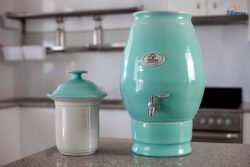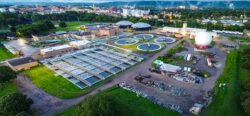
4 Stage Water Filtration System
Understanding the 4-Stage Water Filtration System: A Comprehensive Guide
Water is an essential resource for human life, and ensuring its purity and safety is paramount. A 4-stage water filtration system is an effective method for removing contaminants from drinking water, making it a popular choice for households and businesses alike. This article delves deep into the components, benefits, installation, maintenance, and comparisons with other types of filtration systems to provide an extensive overview of the 4-stage water filtration system.
Table of Contents
- What is a 4-Stage Water Filtration System?
- The Components of a 4-Stage Water Filtration System
- 2.1. First Stage: Sediment Filter
- 2.2. Second Stage: Activated Carbon Filter
- 2.3. Third Stage: Reverse Osmosis Membrane
- 2.4. Fourth Stage: Post Carbon Filter
- Benefits of Using a 4-Stage Water Filtration System
- Installation of a 4-Stage Water Filtration System
- Maintenance of a 4-Stage Water Filtration System
- Comparing 4-Stage Filtration Systems to Other Filtration Types
- 6.1. 2-Stage and 3-Stage Systems
- 6.2. Whole House Filtration Systems
- 6.3. Pitcher Filters and Faucet Attachments
- Environmental and Health Impact
- Conclusion
1. What is a 4-Stage Water Filtration System?
A 4-stage water filtration system is designed to purify tap water through a multi-step process that removes contaminants, chemicals, and impurities. The term "4-stage" refers to the four distinct stages of filtration that the water undergoes, resulting in clean, safe, and great-tasting water. This type of system is particularly effective against a wide range of pollutants, including chlorine, lead, heavy metals, and various microorganisms.
2. The Components of a 4-Stage Water Filtration System
Understanding the components of a 4-stage water filtration system is crucial for grasping how the system works and its effectiveness in purifying water.
2.1. First Stage: Sediment Filter
The sediment filter is the first line of defense in the filtration process. It is designed to remove larger particles such as sand, dirt, rust, and silt from the water. Typically made of pleated polyester or polypropylene, sediment filters can capture particles down to 5 microns in size.
Function:
- Protects the subsequent filters from clogging and damage.
- Improves the overall quality of the water.
Frequency of Replacement: Every 6 to 12 months, depending on water quality and usage.
2.2. Second Stage: Activated Carbon Filter
The activated carbon filter is essential for removing chlorine, volatile organic compounds (VOCs), and bad tastes and odors from the water. Activated carbon has a vast surface area with many pores, allowing it to adsorb a wide range of chemicals.
Function:
- Eliminates chlorine and improves taste and odor.
- Reduces harmful chemicals, making water healthier.
Frequency of Replacement: Every 6 to 12 months.
2.3. Third Stage: Reverse Osmosis Membrane
The reverse osmosis (RO) membrane is the core of a 4-stage water filtration system. This semi-permeable membrane is capable of filtering out contaminants at a molecular level, allowing only clean water to pass through. It effectively removes contaminants such as lead, arsenic, fluoride, and other dissolved solids.
Function:
- Provides thorough purification by removing over 95% of dissolved solids and contaminants.
- Ensures water quality is safe for consumption.
Frequency of Replacement: Every 2 to 3 years.
2.4. Fourth Stage: Post Carbon Filter
The post carbon filter is the final stage of the filtration process. It is designed to remove any remaining tastes, odors, or impurities that may have escaped the previous stages. This filter often uses activated carbon again to polish the water before it reaches the tap.
Function:
- Ensures the best tasting and smelling water for the end user.
- Serves as a final quality check on the purity of the water.
Frequency of Replacement: Every 6 to 12 months.
3. Benefits of Using a 4-Stage Water Filtration System
The 4-stage water filtration system offers numerous benefits that make it an attractive option for water purification:
-
Improved Water Quality: By removing harmful contaminants and impurities, the system provides high-quality water that is safe for drinking and cooking.
-
Better Taste and Odor: Activated carbon filters eliminate chlorine and organic compounds, resulting in better-tasting water.
-
Health Benefits: The reduction of heavy metals and chemicals in the water contributes to better health and reduces the risk of chronic diseases.
-
Cost-Effective: Investing in a water filtration system can save money in the long run, reducing the need for bottled water and frequent water deliveries.
-
Convenience: Having a dedicated filtration system at home ensures access to clean water at all times without needing to purchase bottled water.
- Environmentally Friendly: Reducing bottled water usage means less plastic waste, contributing positively to the environment.
4. Installation of a 4-Stage Water Filtration System
Installing a 4-stage water filtration system is a straightforward process that can be completed by most homeowners with basic plumbing knowledge. However, it is recommended to consult or hire a professional plumber for installation, especially for those unfamiliar with home plumbing systems. Here’s a general overview of the installation steps:
Step 1: Choose the Location
Select an appropriate location under the kitchen sink or in a utility area. Ensure there is sufficient space for the unit and the additional components, such as a storage tank if required.
Step 2: Gather Materials
Ensure you have all the necessary materials, including the filtration unit, connectors, tubing, and any tools required for installation.
Step 3: Shut Off the Water Supply
Before beginning installation, turn off the cold water supply to avoid leaks and spills.
Step 4: Install the Faucet
If your system includes a dedicated faucet, install it according to the manufacturer’s instructions by drilling a hole in the sink or countertop.
Step 5: Connect the Unit
Connect the filtration system to the cold water supply line. Use the provided connectors to ensure a tight fit.
Step 6: Install the Drain Line
If the system has a drain line, connect it to the kitchen sink drain to remove waste water.
Step 7: Test for Leaks
Once everything is connected, turn on the cold water supply and check for leaks at all connection points. Rectify any leaks before water usage.
Step 8: Flush the System
Before using filtered water, allow the system to run for a few minutes to flush out any carbon dust or impurities released during the installation process.
5. Maintenance of a 4-Stage Water Filtration System
Maintenance is key to ensuring the longevity and efficiency of a 4-stage water filtration system. Here are some essential maintenance tips:
Regular Filter Replacement
- Sediment Filter: Replace every 6 to 12 months.
- Activated Carbon Filter: Replace every 6 to 12 months.
- Reverse Osmosis Membrane: Replace every 2 to 3 years.
- Post Carbon Filter: Replace every 6 to 12 months.
Check Connections Periodically
Inspect the filtration system periodically for leaks or loose connections. Re-tighten or replace any damaged parts promptly.
Clean the System
If the system has any washable components, ensure they are cleaned regularly to prevent clogging and maintain water quality.
Monitor Water Quality
Conduct regular water quality tests, especially if you notice changes in taste, odor, or appearance.
6. Comparing 4-Stage Filtration Systems to Other Filtration Types
When it comes to water filtration, there are various options available. Here’s how the 4-stage water filtration system compares to other common types:
6.1. 2-Stage and 3-Stage Systems
-
2-Stage Systems: Typically include a sediment filter and an activated carbon filter. While effective against sediments and chlorine, they do not provide the deep purification that a 4-stage system does.
- 3-Stage Systems: Often include a sediment filter, activated carbon filter, and a single reverse osmosis membrane. While improved over 2-stage systems, a 4-stage system adds an extra level of purification with the post-carbon stage, ensuring better taste and odor removal.
6.2. Whole House Filtration Systems
Whole house filtration systems treat water at the entry point to the home, providing filtered water to every tap. While they are effective for sediment and chlorine reduction, they may not provide the level of purification achieved through a 4-stage filtration system, especially regarding dissolved solids. Whole house systems can be more expensive and may require professional installation.
6.3. Pitcher Filters and Faucet Attachments
Pitcher filters and faucet attachments are convenient and inexpensive options for filtering water. However, they typically have limited filter capabilities and may not remove as many contaminants as a 4-stage system. Their capacity is also smaller, which means they require more frequent refilling and replacement.
7. Environmental and Health Impact
Investing in a 4-stage water filtration system has both environmental and health benefits. By reducing reliance on bottled water, households can significantly decrease their plastic waste output, leading to less environmental pollution and the conservation of resources in producing and transporting bottled water.
On the health front, many municipal water supplies contain traces of harmful substances. A 4-stage system provides a robust safeguard against these contaminants, promoting healthier choices for families. In an era of increasing health consciousness, ensuring access to clean water can reduce the risk of waterborne illnesses and conditions linked to long-term exposure to pollutants in the water supply.
8. Conclusion
A 4-stage water filtration system offers a comprehensive solution for purifying drinking water, combining effectiveness, convenience, and cost savings. With its robust multi-stage approach, this system ensures that families enjoy clean, safe, and great-tasting water right from their taps.
By understanding the components of the system, its installation and maintenance, and how it compares to other filtration options, consumers can make informed choices about their water supply. With ongoing concerns about water quality in many regions, investing in a 4-stage water filtration system is not just a wise decision—it’s an essential step towards healthier living and sustainability.
Choosing the right water filtration system for your needs can vastly improve your quality of life, making water not only a necessity but an enjoyable aspect of your daily routine. Whether for drinking, cooking, or other household uses, the benefits of a 4-stage water filtration system are clear, paving the way towards a healthier future.

